Chernihiv Has Oldest Architectural Monument of Kyivan Rus
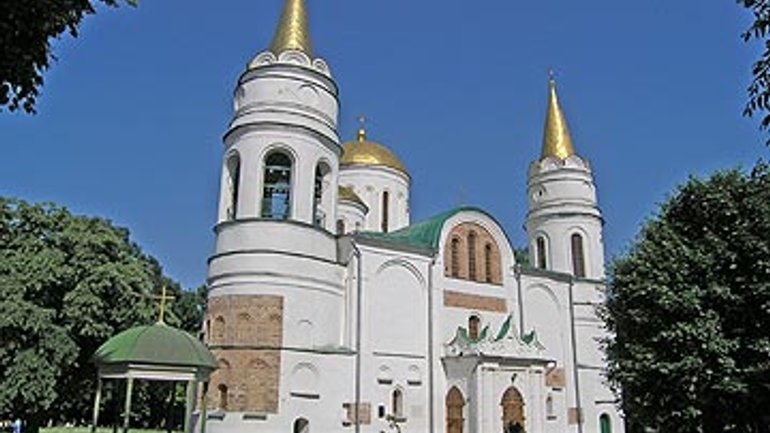
RISU’s Ukrainian-language site posted the story on 6 June 2007.
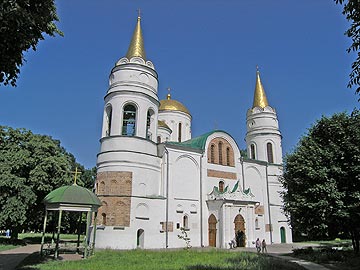 The mapping plan and spatial arrangement of the cathedral is unique. No churches of old Rus have similar mapping. It combines the scheme of a Byzantine cross and domes with elements of a Roman basilica.
The mapping plan and spatial arrangement of the cathedral is unique. No churches of old Rus have similar mapping. It combines the scheme of a Byzantine cross and domes with elements of a Roman basilica.
This fact can be explained only in the following way: Prince Mstyslav, brother of Yaroslav the Wise and founder of Transfiguration Cathedral, invited masters from Tmutarakan on the Black Sea, where he had ruled before Chernihiv. The masters knew traditions of worship buildings in the Near East and the Transcaucasus, where similar types of churches were spread.
So, Chernihiv Prince Mstyslav of Tmutarakan started building the cathedral in approximately 1030, a few years earlier than Yaroslav the Wise started St. Sophia’s Cathedral.
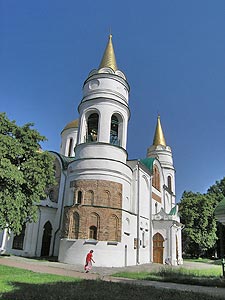 According to legend, a stone church was built instead of a wooden one. In its turn, a wooden church appeared in a place where a pagan temple used to be. The annals give more details. The construction of this glorious building started after the successful campaign of Mstyslav of Tmutarakan and Yaroslav the Wise to occupy Red Rus or Halychyna (now far western Ukraine) and make it part of Rus. Also according to the annals, in 1036 Mstyslav went hunting, became ill, and died. At the time of his death the walls of the church were so high that “you could reach the top of them sitting on a horse.” The prince was buried in the church, anyway.
According to legend, a stone church was built instead of a wooden one. In its turn, a wooden church appeared in a place where a pagan temple used to be. The annals give more details. The construction of this glorious building started after the successful campaign of Mstyslav of Tmutarakan and Yaroslav the Wise to occupy Red Rus or Halychyna (now far western Ukraine) and make it part of Rus. Also according to the annals, in 1036 Mstyslav went hunting, became ill, and died. At the time of his death the walls of the church were so high that “you could reach the top of them sitting on a horse.” The prince was buried in the church, anyway.
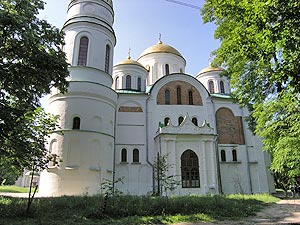 The church became the most important shrine of the Chernihiv-Siverske area even before construction was finished. The relics of saints and wonder-working icons were kept here. Princes and bishops of the eparchy were buried here. Transfiguration Cathedral was the main church in the Chernihiv Eparchy and the center of civil and political life for more than 900 years. Agreements between princes were affirmed here by oaths and kissing the cross.
The church became the most important shrine of the Chernihiv-Siverske area even before construction was finished. The relics of saints and wonder-working icons were kept here. Princes and bishops of the eparchy were buried here. Transfiguration Cathedral was the main church in the Chernihiv Eparchy and the center of civil and political life for more than 900 years. Agreements between princes were affirmed here by oaths and kissing the cross.
This cathedral has three naves. Its width is 22.4 meters, the length with apse 35.25 meters. The height from the floor to the vaults of the central dome is 30 meters. The size of the church inside is the same as of a nine-storey building. The wide foundation is 2.8 meters in the ground. The 1.4 meter walls are almost undamaged today. There is a discussion between researchers if the type of the church is four-, six-, or eight-pillar, because of the complicated mapping.
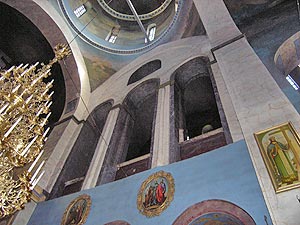 The design of the church is astonishing in its majesty. The curvilinear surfaces of numerous arches rhythmically reoccur, showing the height of the central part of the church. The walls inside the church, vault and pillars were covered with frescos. The colors were rich and accompanied by a bright floor made out of colorful stones and ceramic pieces. The church was surrounded with red tablets. Columns were made of white marble.
The design of the church is astonishing in its majesty. The curvilinear surfaces of numerous arches rhythmically reoccur, showing the height of the central part of the church. The walls inside the church, vault and pillars were covered with frescos. The colors were rich and accompanied by a bright floor made out of colorful stones and ceramic pieces. The church was surrounded with red tablets. Columns were made of white marble.
According to the annals, the following persons (in addition to the founder, his wife Anastasia, and his son Evstafii) were buried in the church: Prince Sviatoslav son of Yaroslav of Chernihiv and later Kyiv was buried here in 1076; his son Hlib in 1078; Oleh son of Sviatoslav in 1115; Volodymyr son of Davyd in 1161; Sviatoslav son of Oleh in 1165; and Vsevolod son of Sviatoslav in 1196. Hierarchs Lazar Baranovych and Amvrosii Dubkevych found eternal rest here in 1693 and 1750, respectively. Ihor Olhovych, a local Chernihiv saint, was also buried here.
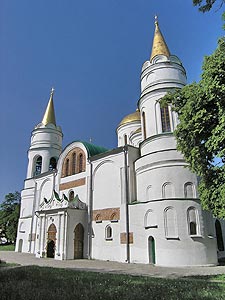 The most significant holy items of the cathedral, kept here until 1917, were relics of Prince Ihor son of Oleh and Metropolitan Kostiantyn, which were kept in the ground near the church walls, and relics of Feodosii Uhlytskyi, saint and Chernihiv archbishop, which lay open in the cathedral (in a silver container of more than 240 kg).
The most significant holy items of the cathedral, kept here until 1917, were relics of Prince Ihor son of Oleh and Metropolitan Kostiantyn, which were kept in the ground near the church walls, and relics of Feodosii Uhlytskyi, saint and Chernihiv archbishop, which lay open in the cathedral (in a silver container of more than 240 kg).
In addition to the relics, the wonder-working icon of the Mother of God of Ripka, honored all over the Chernihiv area since the middle of the 17th century, was kept here.
It is worth saying something separately about the Smolensk icon of the Mother of God. In the time of Kyivan Rus, the depiction of the Hodigitria Mother of God (“She who points the way”) was brought here in 1046 by Anna, daughter of Byzantine emperor Constantine Monomachos and wife of Vsevolod son of Yaroslavov. Volodymyr Monomakh, son of Anna and Vsevolod, began to rule in Smolensk in 1097. He built a church there and took this wonder-working icon from Chernihiv. Since that time people have called it the Smolensk icon. It is believed that Khan Batyi could not take Smolensk in 1239 thanks to the icon’s intercession.
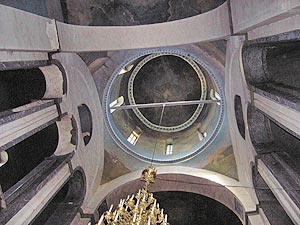 Throughout the centuries, the cathedral was damaged and rebuilt many times. In 1239, during the attack of Khan Batyi, the vault was ruined and the domes destroyed.
Throughout the centuries, the cathedral was damaged and rebuilt many times. In 1239, during the attack of Khan Batyi, the vault was ruined and the domes destroyed.
The church was renewed in the 17th century; apses and baroque domes were built. After a fire in 1750, the church was also rebuilt. At the end of the 18th century, a tower with stairs in the northwest and south parts, where the sanctuary used to be, was built. The roofs were renovated. The facades were plastered and painted. In 1818, spacious tambours (dome supports) were built near the west, north, and south portals. At the end of the 19th century, the domes were gilded and the cathedral gained its modern look.
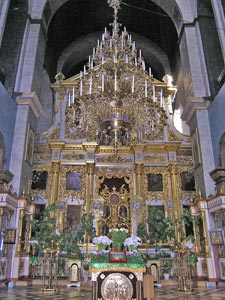 There were also many changes inside the church and with the iconostas.
There were also many changes inside the church and with the iconostas.
There was a tradition to hang the flags of city protectors in the cathedral. Even at the beginning of the 20th century, Cossack flags were kept here. Eighteen of them were of Chernihiv militia during the war with Napoleon. Eleven of them are of militia in the Crimean War in 1853-6.
There were many church supplies in the sacristy of the cathedral made of valuable materials presented by local people and honored guests. These items were artistic and historical artifacts. Unfortunately, not many of them remained here. Today many have been given to the Chernihiv museum. One is a unique work of local jewelers of 1771. It is a Gospel cover with relief pictures. According to the description, it is also known that there was a silver and gold tabernacle, 16.5 kg with a two-storey sarcophagus at the altar of the cathedral from 1782. There was also a cross from 1638, many old liturgical vestments, including those of St. Feodosii of Chernihiv (Uhlytskyi), and a cathedral seat in the choir area given by Empress Catherine during her visit to Chernihiv in 1787.
In 1923, an 11th -century fresco on which half of the figure of St. Thecla was depicted was found in the cathedral. It was under a thick layer of plaster that saved it from numerous fires. In 1926, the icon was removed from the wall and taken to the Chernihiv Regional Historical Museum, where it was kept until the war in 1941. Many exhibits were burned during the war. Fortunately, a very good and exact copy of it from 1934 is kept in St. Sophia’s in Kyiv.
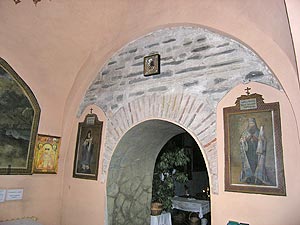 In 1926, the Soviets prohibited Liturgies in Transfiguration Cathedral. At the beginning of the 1930s, the building was transmitted to Holovrosmaslozhyrzbut (the Main Russian Butter and Fat Sellers), where storerooms were made. In 1937, the cathedral was made into a historical museum. In 1942, German occupants allowed Liturgies and the church functioned until 1961. After that, the museum gained its rights as a church again. At the end of the 1980s, the end of so-called “perestroika” (rebuilding), the community of the Ukrainian Orthodox Church–Moscow Patriarchate threw the museum items out of the cathedral, occupied the building with force, and started holding Liturgies. However, to this day many experts and ordinary citizens question the legality of the transfer of the church to the religious community.
In 1926, the Soviets prohibited Liturgies in Transfiguration Cathedral. At the beginning of the 1930s, the building was transmitted to Holovrosmaslozhyrzbut (the Main Russian Butter and Fat Sellers), where storerooms were made. In 1937, the cathedral was made into a historical museum. In 1942, German occupants allowed Liturgies and the church functioned until 1961. After that, the museum gained its rights as a church again. At the end of the 1980s, the end of so-called “perestroika” (rebuilding), the community of the Ukrainian Orthodox Church–Moscow Patriarchate threw the museum items out of the cathedral, occupied the building with force, and started holding Liturgies. However, to this day many experts and ordinary citizens question the legality of the transfer of the church to the religious community.









